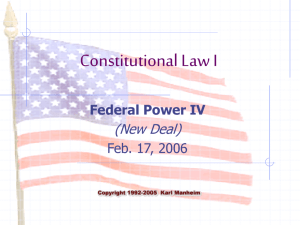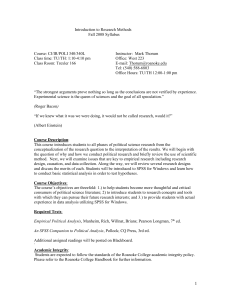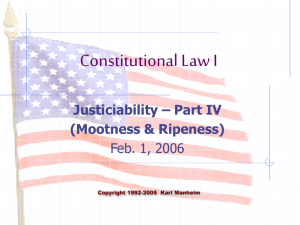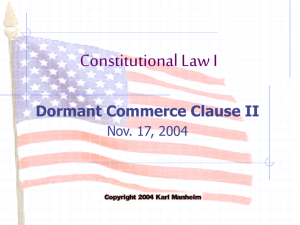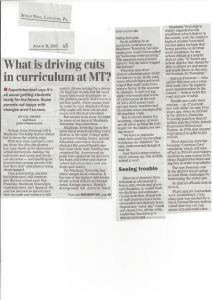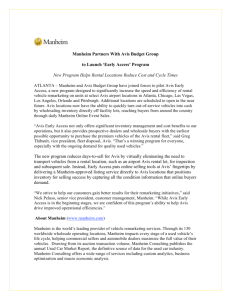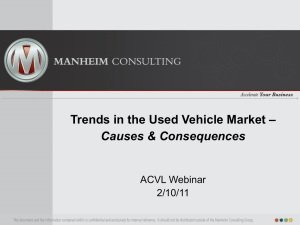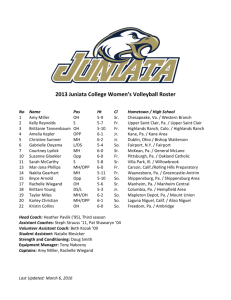PPT
advertisement
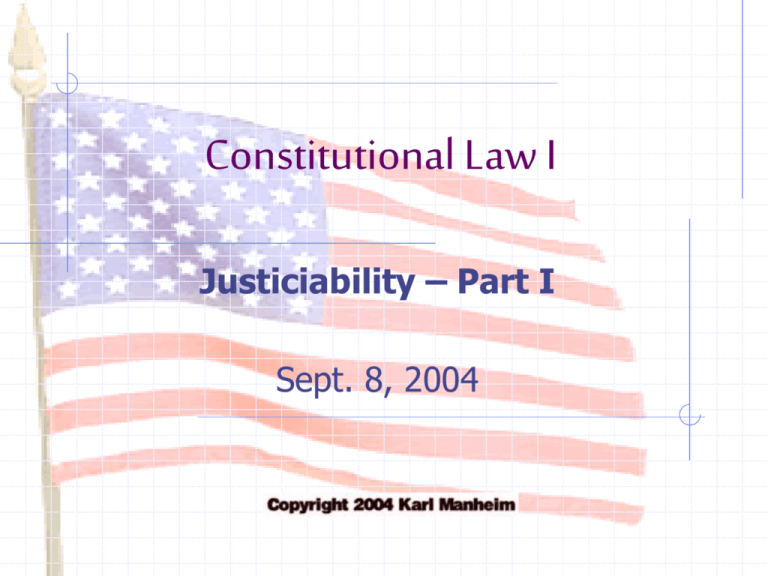
Constitutional Law I Justiciability – Part I Sept. 8, 2004 Types of Limits on Judicial Power Interpretive Limits Statutory Limits Article III Limits (justiciability doctrines) Fall, 2004 ConLawI - Manheim 2 Types of Limits on Judicial Power Interpretive Limits Statutory Limits Article III Limits (justiciability doctrines) Fall, 2004 ConLawI - Manheim 3 Article III Section 2: "The judicial Power shall extend to all Cases, in Law and Equity, arising under this Constitution, the Laws of the United States … to Controversies to which the United States shall be a Party …" Fall, 2004 ConLawI - Manheim 4 Article III Section 2: "The judicial Power shall extend to all Cases, in Law and Equity, arising under this Constitution, the Laws of the United States … to Controversies to which the United States shall be a Party …" The power to apply the law to legal disputes Fall, 2004 ConLawI - Manheim 5 Article III Section 2: "The judicial Power shall extend to all Cases, in Law and Equity, arising under this Constitution, the Laws of the United States … to Controversies to which the United States shall be a Party …" legal dispute between litigants based on facts Fall, 2004 ConLawI - Manheim 6 Article III Section 2: "The judicial Power shall extend to all Cases, in Law and Equity, arising under this Constitution, the Laws of the United States … to Controversies to which the United States shall be a Party …" Synonym for "cases" Fall, 2004 ConLawI - Manheim 7 Case or Controversy requirement Legal dispute between litigants based on actualMarshall: facts “Questions, in their nature or which are, by the Constitution Nopolitical, advisory opinions laws, submitted to the executive, Noand conjectural, premature or stale can cases never be made in this Court." Only litigants with real & personal disputes of adversarial character No political disputes (i.e., matters not suited for adjudication in court of law) Fall, 2004 ConLawI - Manheim 8 Prudential rules (self-restraint) Exercise power of judicial review only as last resort Decide constitutional questions last Decide state issues 1st Decide federal statutory issues 2nd Construe statutes as to render them const'l Decide cases on narrowest grounds Plaintiff must assert personal right Court must be able to issue meaningful relief Fall, 2004 ConLawI - Manheim 9 Advisory Opinions Marshall's syllogism for judicial review Courts must decide cases; If those cases set up the constitution as a right or defense, courts must be allowed to look to the constitution; If the constitution is supreme, it must provide the rule of decision in every case in which invoked but only when necessary to decide actual cases Fall, 2004 ConLawI - Manheim 10 Opinion of the Justices Interpretation of peace treaty Why did Washington/Jefferson want a judicial interpretation? Why didn't Jay want to provide it? If not S.Ct., who gives President legal advice? Art. II, § 2, ¶ 1: "the President … may require the Opinion, in writing, of the principal Officer in each of the executive Departments, upon any subject relating to the Duties of their respective offices …" Contrast state Supreme Courts Fall, 2004 ConLawI - Manheim 11 Judicial Finality Heyburn's Case (1792) Federal Courts cannot make mere "recommendations" to other branches Res Judicata Full effect to decided cases Even if wrongly decided? Fall, 2004 ConLawI - Manheim 12 Plaut v. Spendthrift Farms (1995) Statute of limitations - Rule 10(b)(5) cases S.Ct. interpretation of federal statute? Does S.Ct. ever misinterpret a federal law? What recourse does Congress have? Change in underlying substantive law Applicability for future cases Applicability for case already decided Fall, 2004 ConLawI - Manheim 13 Plaut v. Spendthrift Farms (1995) Change in underlying substantive law Applicability for pending cases Distinction between types of relief sought Retroactive relief (e.g., Klein v. U.S.) When plaintiff seeks a remedy for past harms (e.g., damages, restitution), the law applied is that which existed when cause of action accrued Prospective relief (e.g., Robertson v. Audubon Soc.) When plaintiff demands that defendant comply with the law, to prevent ongoing or future harm, the law applied is the law that exists when judgment is entered Fall, 2004 ConLawI - Manheim 14 UnderStanding Standing Article III courts have limited jurisdiction SoP and Federalism reasons Subject matter limits 9 heads of SMJ in Art. III, §2, ¶ 1 Case & Controversy (types of disputes) These are the justiciability doctrines Standing Ripeness Mootness Political Question Fall, 2004 Const. limits & rules of prudential self-restraint ConLawI - Manheim 15 Standing Theory Federal courts can exercies judicial power only in cases and controversies of an "adversarial nature" To be adversarial, litigants must be in particular relationship with one another such that they have personal stake in outcome of case Judicial power is the power to decide cases. If a federal court is unable to give effective relief, then it is not deciding a case, but merely rendering an advisory opinion. Fall, 2004 ConLawI - Manheim 16 Standing Elements 1. 2. 3. 4. Discrete and Palpable Injury Caused by Defendant's (alleged) Action Remediable by Court Plaintiff's personal rights at stake Fall, 2004 ConLawI - Manheim 17 Allen v. Wright (1984) Players Fall, 2004 W. Wayne Allen, Chairman, Bd of Trustees, Briarcrest Baptist School, Memphis, TN Donald T. Regan, Secretary of Treasury Inez Wright, mother of black pupils ConLawI - Manheim 18 Background “White flight” from public to private schools “Briarcrest Baptist High School, which opened two years ago after the courts ordered busing in the Memphis schools, has just about everything: a lavish $6.5 million building with earphones dangling from the ceiling in language labs, en electric kiln for would-be potters and an enthusiastic and well-educated corps of teachers … “Many of the new private schools, like Briarcrest, insist that they have "open" admissions and are segregated only because no blacks have applied. But they conceded that white hostility to desegregation accounts for much of their growth. "We've got parents who are running from problems," says Wayne Allen, a Baptist minister who is chairman of the Briarcrest board of trustees. "Anyone who says different is not telling the truth." Fall, 2004 ConLawI - Manheim 19 Background “White flight” from public to private schools “The rise of private schools also poses a serious threat to public education in the South. By skimming off the children of many middle-class whites, the segregated academies are helping to turn public schools into "pauper systems", with student bodies that are increasingly black and poor ... “As one 17-year-old student at Briarcrest put it, "I left the public schools to get away from blacks. If they came here, I don't think they would be welcome at all." Time Magazine, Dec. 15, 1975 Fall, 2004 ConLawI - Manheim 20 Background Private schools are expensive Less so (perhaps) if they have alternative sources of income Easier to raise funds (perhaps) if contributions are tax deductible IRS required by statute to deny tax exempt status [501(c)(3)] to racially discriminatory private schools Fall, 2004 But (alleged) IRS failed to follow standards set by S.Ct. in Bob Jones University v. U.S. (1983) ConLawI - Manheim 21 Allegations Tax-exempt status constitutes federal financial aid in violation of statute Fall, 2004 NB: probably not a constitutional violation ConLawI - Manheim 22 Standing Elements 1. 2. 3. 4. Discrete and Palpable Injury Caused by Defendant's (alleged) Action Remediably by Court Plaintiff's personal rights at stake Fall, 2004 ConLawI - Manheim 23 Standing Elements 1. 2. 3. 4. Discrete and Palpable Injury Irreducible minimums Caused by Defendant's (alleged) Action of Article III Remediable by Court Plaintiff's personal rights at stake Fall, 2004 ConLawI - Manheim 24 1. Discrete and Palpable Injury Discrete (or distinct): “constituting a separate entity : individually distinct” Not generalized Palpable: Claimed injuries 1. Harmed by gov’t aid to discrim. schools a. Right to have gov’t obey the law b. Stigmatic injury (contrast personal discrimination) “easily perceptible” 2. Harmed by denial of Not abstract or conjectural integrated education Must be “judicially “One of the most serious injuries cognizable” recognized in our legal system” Fall, 2004 ConLawI - Manheim 25 "Judicially Cognizable" injuries Hohfeldian injuries Injury to person or property Non-Hohfeldian injuries Injury to positive rights Constitutional rights (e.g., Wright) Most stautory rights (e.g., FEC v. Atkins (1998)) Other personal interests No, unless recognized by law (e.g., common law) Abstract (philosophical) injuries Fall, 2004 Not usually ConLawI - Manheim 26 2. Causation Plaintiff’s injury must have been caused by defendant’s (allegedly) illegal conduct “fairly traceable” Elsewise, not a “controversy” between these parties IRS wrongly confers tax-exempt status White flight, which deprives Pl’s of integrated education Line of causation Fall, 2004 ConLawI - Manheim 27 2. Proving Causation Does tax-exempt status cause segregated public schools? Fall, 2004 Is it tantamount to a “subsidy for the withdrawal of a white child”? [Stevens] Even if it is, how does it cause segregation? ConLawI - Manheim 28 3. Redressability Court must be able to fashion a remedy that will alleviate plaintiff’s injury Often the flip side of causation inquiry Sometimes due to nature of requested relief Example: Linda R.S. v. Richard D. (1973) Jailing father for non-support doesn't get mother more $$ Example: Warth v. Seldin (1975) Invalidating exclusionary housing ord. does not necessarily result in more affordable housing Inability to alleviate the injury is tantamount to rendering an "advisory opinion" Fall, 2004 ConLawI - Manheim 29 2. Proving Causation Do uncertainties about the Does tax-exempt actions status cause segregated of third parties break public schools? the chain of causation? Would denying exempt status result in better-integrated public schools? Raise tuition at discriminatory private schools or cause them to change their policies? Result in some white students not enrolling? Would they attend local public schools instead? Would that be sufficient “integration”? Fall, 2004 ConLawI - Manheim 30 2. Proving Causation Is Causation element result oriented? Simon v. Eastern Kentucky Welfare Rights Org Would losing tax-exempt status induce hospitals to provide free medical care to indigent patients? Duke Power v. Carolina Env. Study Group Would removing cap on liability induce power cos to close nuclear power plants? How do you “prove” this line of causation? When should you have to prove it? Fall, 2004 ConLawI - Manheim 31 2. Proving Causation When? Justiciability is a prerequisite to jurisdiction Must be satisfied at all stages of litigation Who? Party invoking fed. jdx. has burden of proof How? Pleading stage: factual allegations sufficient Pre-trial stage: specific facts / triable evidence Should the std. of proof be greater if facts supporting causation are in plaintiff’s control (vs. 3rd party)? Fall, 2004 Trial: proof by preponderance of evidence ConLawI - Manheim 32 2. Proving Causation Also an element of most causes of action Proof needed to prevail on claim Also an element for injunctive relief Pl. must establish both ongoing or imminent injury resulting from Def’s continued action Courts often confuse standing causation with claim or relief causation Fall, 2004 ConLawI - Manheim 33 4. Personal rights at stake The right being enforced must belong to plaintiff Here, the right is a statutory one: no taxexempt status for discriminatory private schools Is Inez Wright the intended beneficiary of this right? Did Congress intend for her to enforce it? Perhaps this is what J. O’Connor means by standing (in this case) raising SoP concerns Fall, 2004 ConLawI - Manheim 34

